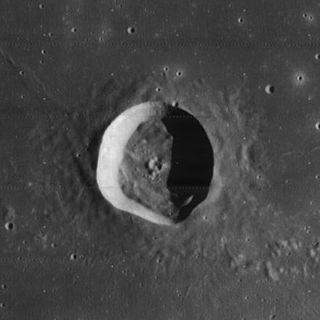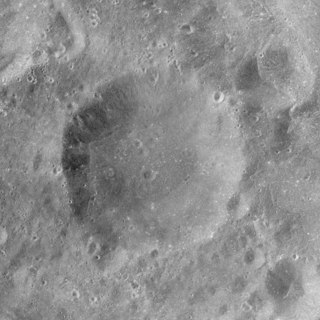
Eddington is the lava-flooded remnant of a lunar impact crater, located on the western part of Oceanus Procellarum. The western rim is attached to the wall of the walled plain Struve. To the east-southeast is the smaller but prominent crater Seleucus. South of Eddington is Krafft.

Cavendish is a lunar impact crater that is located in the southwest part of the Moon, to the southwest of the larger crater Mersenius. It lies between the smaller craters Henry to the west-northwest and de Gasparis to the east-southeast.

Doppelmayer is the remains of a lunar impact crater that lies on the southwest edge of Mare Humorum. It was named after the German mathematician and astronomer Johann Gabriel Doppelmayr. To the south-southeast is another flooded crater designated Lee, and to the southeast is Vitello. Just to the east-northeast of Doppelmayer lies the nearly submerged crater Puiseux.

Flamsteed is a small lunar impact crater located on the Oceanus Procellarum, which is named after British astronomer John Flamsteed. It lies almost due east of the dark-hued Grimaldi, and north-northwest of the flooded Letronne bay on the south edge of the mare.

Dawson is a lunar impact crater that lies on the southern hemisphere on the far side of the Moon. It lies across a crater triplet: the southeast rim is intruding into the crater Alekhin; the northwest rim also intrudes into the larger satellite crater Dawson V, and the northeast rim is attached to the comparably sized Dawson D. To the south of this formation is the large crater Zeeman. West of Dawson is the crater Crommelin, and to the north lies Fizeau.

Borda is a lunar impact crater that lies between Santbech to the north-northwest and Reichenbach slightly further away to the south-southeast. It was named after French astronomer Jean-Charles de Borda. It has a low rim that is broken along the southeast by a smaller crater. The rim is intruded into by another small crater along the southwest side, and there is an irregular cleft along the northwest face. There is a central peak at the midpoint of the floor.

Bellinsgauzen is a lunar impact crater that lies in the southern part of Moon, on the far side from the Earth. It is attached to the northern rim of the larger crater Berlage, and within a half crater diameter of Cabannes to the west. North of Bellinsgauzen is the crater Bhabha.

Barringer is a lunar impact crater that is located on the southern hemisphere on the far side of the Moon. It is attached to the north-northeastern rim of the walled basin named Apollo, and lies to the southeast of Plummer. South of Barringer, on the floor of the Apollo basin, is the crater Scobee.

Barbier is a lunar impact crater that is located on the southern hemisphere on the far side of the Moon. It forms a matched pair with Cyrano to the north-northwest, and it lies to the southeast of the huge walled plain Gagarin. Southwest of Barbier is the crater Sierpinski, and to the southeast is the Mare Ingenii.

Boussingault is a large lunar impact crater that lies near the rugged southeast limb of the Moon. Because of its location, Boussingault appears highly oblong in shape due to foreshortening. To the southwest is the crater Boguslawsky, and almost attached to the northeast rim is Helmholtz. East-southeast of Boussingault lies the crater Neumayer.

De Roy is a lunar impact crater that is located on the far side of the Moon, just behind the southwestern limb. This portion of the lunar surface is brought into view during favorable librations, allowing observation of this formation. However the crater is viewed from the side when watched from the Earth, and little detail can be seen. De Roy lies to the west of the crater Arrhenius, and east of the larger Boltzmann.

Casatus is a lunar impact crater that is located near the southern limb of the Moon. The north-northeast rim of the crater overlies a portion of the slightly larger crater Klaproth. Along the western rim, Casatus A intrudes somewhat into the interior, producing an inward-bowing rim. To the southeast of Casatus is Newton.

Cook is a lunar impact crater that lies in the western part of the Mare Fecunditatis, just to the southeast of the prominent crater Colombo. To the southwest is Monge.

Cichus is a lunar impact crater that lies in the southwestern part of the Moon, at the eastern edge of Palus Epidemiarum. Just to the northeast and nearly contacting the rim is the lava-flooded crater remnant Weiss. The crater is named after Italian astronomer Cecco d'Ascoli.

Chandler is a lunar impact crater in the northern hemisphere, on the Moon's far side. It lies to the southeast of the large walled plain D'Alembert, and southeast of the slightly smaller Chernyshev crater.

Cockcroft is a lunar impact crater that is situated on the far side of the Moon from the Earth, so that it has only be observed and photographed from orbit. It lies to the northeast of the larger crater Fitzgerald, and southeast of Evershed.

Dziewulski is a lunar impact crater on the far side of the Moon. It lies between the craters Edison to the north and Popov to the south. The outer rim of this crater has been considerably worn by impacts, particularly along the southwest quadrant where the satellite crater Dziewulski Q overlies the rim and the interior floor. The northern rim is also heavily disrupted, and several small crater lie along the southeast rim. The interior floor and surrounding terrain has been resurfaced.

Eötvös is the remains of a lunar impact crater on the far side of the Moon. It lies to the north-northwest of the walled plain Roche, and east-southeast of the equally ruined Bolyai.

Fersman is a large lunar impact crater on the Moon's far side. It lies to the east of the crater Poynting, and west-northwest of Weyl. To the south is the huge walled plain Hertzsprung.

Viviani is a small lunar impact crater that lies on the far side of the Moon. It was named after Italian mathematician and physicist Vincenzo Viviani. It is located due west of the prominent crater King, and just to the southeast of Katchalsky.

























